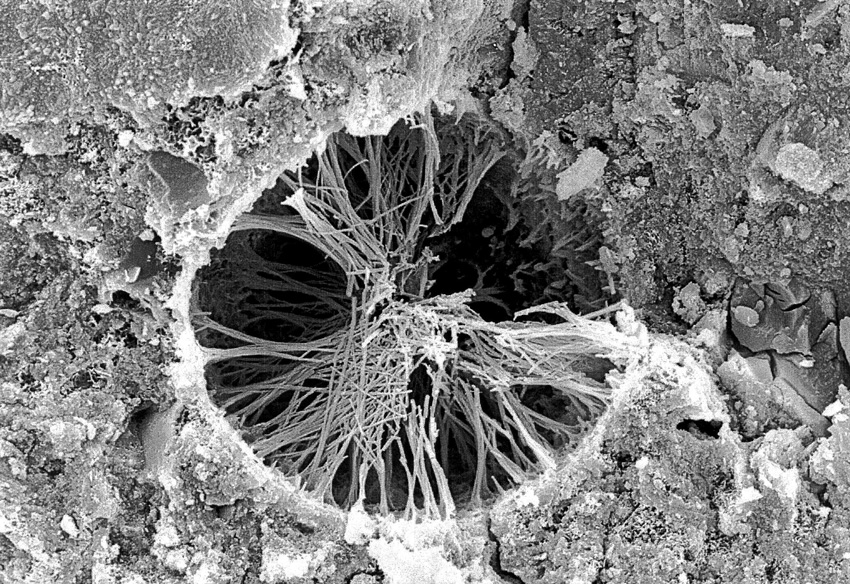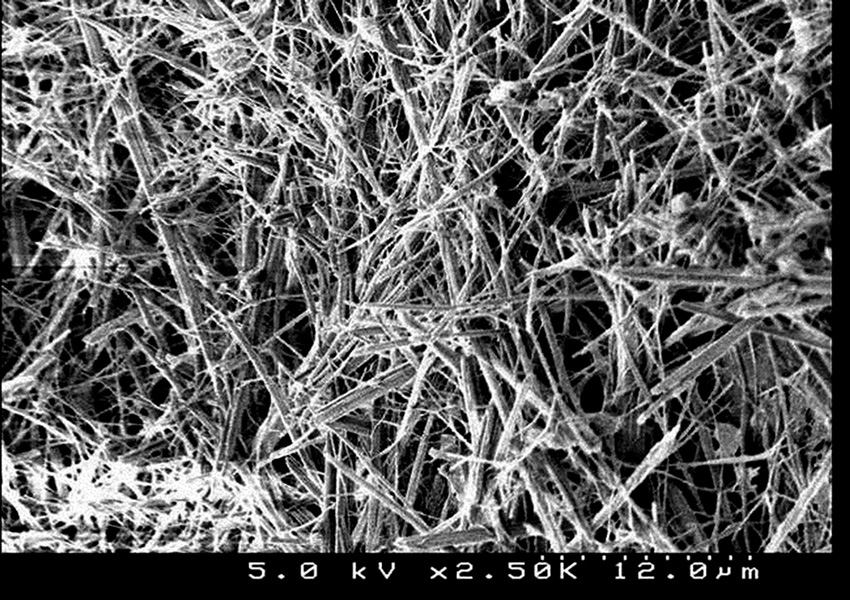Improving Concrete Durability with Crystalline Technology
The Solution: Chemistry
Each of the causes of concrete deterioration that we have discussed can produce aesthetic, functional or structural problems if not treated properly or addressed ahead of time. To overcome these problems, there are several approaches. A common one is to use a surface coating in response to the need to waterproof the concrete to keep not just water out but chemicals and other substances too. Such solutions are based on applying a protective coating over the concrete after it is fully cured. While there are certainly some good and well-known products available for this, with the exception of crystalline technology coatings, their inherent limitation is that they are not integral to the concrete—they are all an applied layer on top of it. This means their success is entirely dependent on their adhesion to the concrete surface to prevent it from separating and peeling off, leaving the concrete exposed. They also require ongoing maintenance to be sure that the coating remains intact and continues to protect the concrete over time.
Chemical admixtures are another approach to address the properties and capabilities of concrete. They are an integral solution generally regarded as a superior approach that has been used for decades to improve the performance of concrete in a variety of ways. Their first widespread use was to extend the temperature range that concrete could be poured without fear of freezing. They also became common to improve the workability of concrete through plasticizers that allowed less water in the mix, while still retaining adequate slump (formability). Building on this proven success, it is possible to combine careful attention to the mix of concrete ingredients with appropriate chemical admixtures that can yield solutions to overcome deterioration challenges. This is particularly true through the use of admixtures that employ crystalline technology to achieve some impressive results.

A scanning electron microscope image of crystalline formation in a concrete pore shows its ability to fill and plug the voids inherent in concrete.
Crystalline Technology: What It Is and How It Works
Crystalline technology takes advantage of the natural and porous characteristics of concrete. With water as the catalyst, specific chemicals are used that react with the natural by-products of cement hydration (calcium hydroxide, mineral salts, mineral oxides, and unhydrated and partially hydrated cement particles). This reaction forms a nonsoluble crystal that grows to form a web-like crystalline structure within the interconnected pores and other voids in concrete. In this way, the crystalline structure becomes a permanent, integral part of the concrete itself. Because it is nonsoluble, it fills the voids, cracks, capillaries, pores and other openings to make the concrete impermeable, thus preventing the ingress of water and other liquids even under strong hydrostatic pressure. That means it also protects against liquid-borne chemicals that can deteriorate concrete or corrode steel reinforcing, even in harsh, aggressive environments.
When a cement particle hydrates, the reaction between water and the cement causes it to become a hard, solid, rocklike mass. The reaction also generates chemical by-products that lie dormant in the concrete. Crystalline technology adds another set of chemicals to the mixture. When these two groups, the by-products of cement hydration and the crystalline chemicals, are brought together in the presence of moisture, a chemical reaction occurs, which produces a new nonsoluble structure in the capillaries, micro-cracks and shrinkage cracks that are found in the concrete. By means of the crystalline reaction, the porosity of the concrete is plugged, and the ability of water or water-borne chemicals to penetrate the substrate is prevented.
Integral crystalline technology products are manufactured in the form of a dry powder compound consisting of portland cement, very fine treated silica sand and selected chemicals. It is the chemicals that react with the by-products of cement hydration to produce the nonsoluble crystalline formation. Specific formulations are produced for application either as a coating material, concrete admixture or dry shake product. It can be incorporated into a structure as it is being constructed or later on in the life cycle as a maintenance material that will further enhance its durability.
Crystalline Technology: What It Does
Scanning electron microscope images have provided a closeup view of how newly formed crystalline structures bridge and seal the capillary tracts and cracks in concrete. This directly reduces the diffusion of liquids and aggressive substances into the concrete and significantly extends the life of the structure. As such, crystalline technology has been shown to provide the following characteristics:

The integral capabilities of crystalline technology mean that the entire concrete structure is protected and made resistant to water and other penetrating substances.
- Provides Integral Concrete Waterproofing: Crystalline technology is an integral solution for reducing the permeability of concrete. When it reacts with the by-products of cement hydration to produce a nonsoluble crystalline structure, it blocks up the voids, openings, and other paths or passages that define the typical porosity of concrete. By plugging the pores, capillary tracts and micro-cracks with a crystalline formation, the diffusion of liquids and gases is significantly reduced, thus protecting concrete structures against effects of water penetration, including freeze-thaw cycles and water borne chemical attacks. Further, since all causes of deterioration need these paths and passages in order to diffuse into the concrete, their blockage defends against other attacks as well.
- Resists Acid Attacks: Concrete can be attacked by acidic or caustic materials, as we have seen. Acids in liquid form attack concrete by penetrating the concrete through its inherent capillary porosity as well as micro- and macro-cracks. Once inside concrete, the acid reacts with calcium hydroxide to form a calcium salt, which is easily separated from the cement resulting in a weakened paste structure. Once all of the calcium hydroxide is consumed, the acid will then attack the calcium silicate hydrate, which is the true cementing mechanism holding all of the aggregates together, and this can cause substantial structural damage to concrete. By using crystalline technology to block up the capillaries and pores of the concrete to begin with, these acidic chemical reactions and deterioration of concrete are significantly reduced.
- Resists Sulfate Attacks: Similarly, by using crystalline technology to waterproof the concrete and decrease its permeability, the amount of sulphate ions that can diffuse into the pores of the concrete is greatly diminished. When the sulphates are restricted from entering the concrete, sulphate attack is reduced, while the resistance and durability of the concrete is increased. It is also worth remembering here that the reactive chemicals in crystalline technology combine with various calcium compounds in the concrete. These calcium compounds are given off as by-products of cement hydration and are a primary building block for sulphate corrosion. By reacting with calcium hydroxide and turning it into a nonsoluble complex, the crystalline technology limits the amount of free CH available for the initial sulphate reaction. This has a direct effect on reducing the rest of the sulphate corrosion process.
- Inhibits the Effects of Carbonation: Crystalline formation in the capillary tracts has been shown to reduce not only water but also the flow of gases into concrete. Since carbonation is dependent on CO and CO2 penetrating the surface of the concrete, particularly in humid applications, crystalline technology significantly retards the carbonation process.
- Reduces Chloride Ion Attacks: A common problem for marine structures, bridges and concrete structures along roadways in cold climates is chloride attack, which occurs when chloride ions reach the steel reinforcement via interconnected pores and cracks in the concrete. Once the chloride ions have reached a critical concentration level, they are able to break down the naturally passivating alkaline film surrounding the steel and form an electrochemical corrosion cell. This results in the breakdown of the steel and the formation of rust, which occupies a larger volume than the original steel and ultimately weakens the structure. Crystalline waterproofing has been shown to reduce the diffusion of chlorides in concrete structures by preventing liquids carrying chloride ions from ever reaching the steel. This helps protect reinforcing steel and prevents deterioration that could occur from oxidation and expansion of steel reinforcement.










